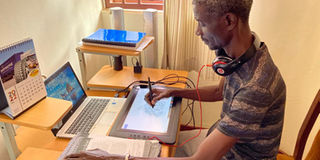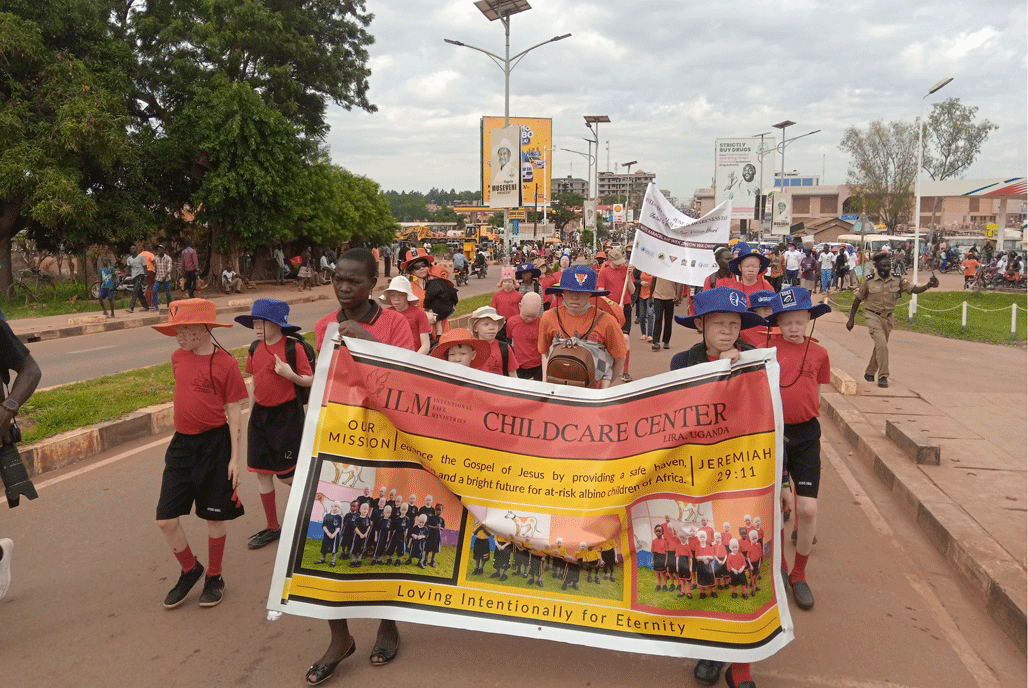Prime
Banga: Making public artworks accessible for visually impaired

Simon Banga in his art studio in Kampala. Photo/ Courtesy
What you need to know:
- He is currently in the process of transcribing two public art works; the Kabaka Mutebi Monument at Bulange in Mengo and the Kawalya Kaggwa Monument on Kampala Road.
Ugandan artist and activist Simon Banga is on a mission to make public artworks accessible to the visually impaired persons by transcribing national historical monuments into braille and tactile formats.
The 50-year-old fine artist, says he has so far transcribed five monuments in Kampala that include the Independence Monument at Speke Road, the Journey Monument at the Kololo Independence Grounds, the World War Monument at City Square, the Stride Monument situated between the Uganda Parliament Gardens and Kampala Serena Hotel, and the Centenary Monument at Centenary Park.
He is currently in the process of transcribing two public art works; the Kabaka Mutebi Monument at Bulange in Mengo and the Kawalya Kaggwa Monument on Kampala Road.
The first stage
Banga is producing his artworks under his project dubbed Braille-as-Art which is an illustrative platform and a reinterpretation of the monuments that is giving a chance to the blind to interpret artworks with a sense of touch and to access public monuments in Kampala.
The art lecturer says the process of transcribing monuments for the blind goes through three stages.
“The process begins with translating monuments into photographic information so as to get a way to create the monuments in a manageable format that can be accessed by the visually impaired unlike the gigantic formats in which the originals were created hence making them inaccessible to persons with disabilities (PWDs).”
“I go on to create sketches using photography as my reference of the selected monuments. The idea of sketches is to get a way to transcribe the monuments into simple lines and shapes but maintaining form and originality of the monuments. Photography-sized can be an end in itself and become a stepping stone to transcribe and interpret the public monument to open access for the blind,” he adds.
The second and third stage
Herein, Banga explores different techniques and mediums to produce the monuments as illustrations.
“Here I started with testing different media on different surfaces such as water colour on paper, charcoal on paper and scram led paper. This is done because the blind experience seeing through touch,” Banga explains.
“In the third stage, I transcribe the illustrations into braille as art. At this stage I have to further simplify the monuments into simple basic shapes and structure avoiding all unnecessary details such as colour and tones which the blind cannot access,” Banga adds.
As to what forms these interpretations take, Banga, says, “They will take on all-inclusive interpretations meaning they will have both text for the visually-paired and braille for the impaired to rule out discrimination between audiences.”
Banga presented the Independence Monument that he re-created through cotton cloth and manila paper at the month-long group exhibition titled, Tracing the Que-rator that ran from March 25 to April 22, at the Nommo Gallery in Kampala.
The Independence Monument made of cement was created by Gregory Maloba in 1962 in commemoration of Uganda’s independence from Britain. The six-metre tall monument depicts a mother with legs apart carrying a child whose hands are raised to portray independence.
Inspiration
Asked what drives him in this project to make public art accessible to the blind, Banga replied: “I am driven by Article 21 of the Ugandan Constitution that prohibits gender discrimination generally and promotes equality before the law regardless of sex, colour, ethnicity or region or political beliefs or social standings public spaces not excluded.”
On what inspired him into this cause, Banga says he was inspired by a project titled Kampala’s Public Monument’s Allegories of Exclusion: Perspectives of Governance, Human Rights and Development funded by the Carnegie Cooperation in US. There, he used braille and tactile as platform to render Kampala’s public monuments accessible to the visually impaired.
Dr Angelo Kakande, artist, art historian, and human rights lawyer won the Carnegie Corporation grant through Makerere University. Dr Kakande, an associate professor at Makerere University, says he used part of the money to train Banga. Dr Kakande and Prof Amanda Tumusiime were the supervisors for Banga’s braille art project.
The beginnings
Banga says he began this journey by enrolling for a course in the braille language at Enabling Services Uganda Limited in Kampala.
“I started with simple line art with very minimal details that can easily be transcribed into braille and tactile and later on I took on a one month’s course in Braille Grade One,” he recounts.
According to Banga, Uganda is one of the African countries that have taken significant strides towards embracing laws and policies that guarantee the visually challenged to access public spaces.
“However, this success has not been realised with respect to public culture and art for example all the monuments located in Kampala are not accessible for the visually impaired. It is from this background that I produced artworks that can be rendered accessible using illustration as a tool,” he says.
“Transcribing national monuments into formats accessible to the visually impaired is an obligation under the international and national laws applicable in Uganda. However, Uganda has been slow to fulfill this,” says, Dr Kakande.
Asked how he goes about identifying public art that should benefit the visually impaired persons, Banga replies: “Firstly, the location of these monuments in Kampala as central business district, and, secondly all the monuments I selected have a country’s history attached to them.”

Transcribed. The Independence Monument in braille
Does he plans to put a braille interpretation at each public art installation? Banga says: “Yes, although this comes with challenges because braille and tactile are expensive to produce.”
Banga adds that the project adds a body of knowledge on the challenges of accessing all- inclusive information both public and private for the visually impaired persons. Also, it inspires artists to produce work in line with the needs of PWDs.
In Dr Kakande’s view, Banga’s project makes selected national art forms accessible to the visually impaired. However, this accessibility might be limited to those who can read braille and these are not the majority of persons with visual impairment.
“However, it is a welcome contribution which fills a critical gap in the country’s cultural landscape.”
Reception
The commissioner, museums and monuments, Ministry of tourism, wildlife and antiquities, Rose Mwanja referred to Banga’s project as a brilliant idea, and her department is willing to work with Banga in order to popularise national monuments among the blind.
“That is a new audience that we have not yet been able to address. Definitely the department would be excited to be part of the project so that it can record the impact on this group of people,” Mwanja says.
This is a politically correct project that will raise public sentimentality and sympathy. When asked what the economic sense is and how many blind people access public art in Uganda, Banga says: “Braille is an expensive venture in terms of hard and software. Therefore, few blind people can access braille equipment.”
UNESCO is convinced that the inclusion of persons with disabilities through arts, music, dance and other cultural expressions using digital tools is essential to meet the promise of the 2030 Agenda for Sustainable Development to “leave no one behind.”
When asked if the creators of public art or monuments take care of PWDs in Uganda, Banga replied: “On paper yes, however, they were aware that PWD’s exist until my intervention exposed this gap.”
Art is about connecting with people’s emotions and universal.
“However, in Uganda art is looked at as something for the visually paired persons. My exhibition for the blind access was opened and hence creating a link between disability and art.,” Banga explains.

A visually-impaired person touches and braille images of the monuments illustrated by Simon Banga at Humura Hotel in Kampala in 2014. Photo/Courtesy
“I am an artist, art historian and a lawyer by training. I link disability and art by making art and publishing articles and book chapters on Uganda’s contemporary art while linking it to issues of human rights including the rights of PWDs,” Dr Kakande says.
How Covid-19 has affected him as an artist: “The confinement measures in place affected the production of art due to the scarcity of materials.
Who is Banga?
Born in Kampala in 1972, Banga is married to Judy Nyirinkindi and they have three daughters. He he teaches drawing, illustration and computer-aided design at Kyambogo University in Kampala. He previously taught at Makerere University.
He held “All the Light We Can: An exhibition of artworks in which public monuments in Kampala have been rendered accessible for persons.
Banga attended Namasumbi Secondary School in Mukono District and Makerere High School, Kampala.
He holds an upper second Bachelor’s Degree in Fine Art (1994-1997) and a Master’s in Visual Communication and Illustration (2015-2017) from Makerere University in Kampala.
Quick notes
Why visually impaired persons have not been catered for in such public art forms.
“First, the artists who make these art forms have in their minds Ugandans who have eyes to see and can therefore, visually access the national art forms. Persons with visual impairment are, as such, excluded from the category of the public that can consume the national monuments.”
“Secondly, at the policy and legislative levels, the country has not prioritised the [re]production of the national art forms using formats accessible to the visually impaired,” Dr Kakande adds.
Current state of the fine art industry in Uganda: “Ugandans attach little value to art as opposed to foreigners.” Foreigners are the main buyers of Ugandan art.
He “winds” down by: Taking a cup of coffee while watching YouTube videos.
What drives Banga: “Being open to possibilities with willingness to take on new challenges and engage creatively as often in many ways I can.” Banga says the form of art he practices includes creating murals, illustrations, collaborating with community arts projects as well as mentoring young artists.





